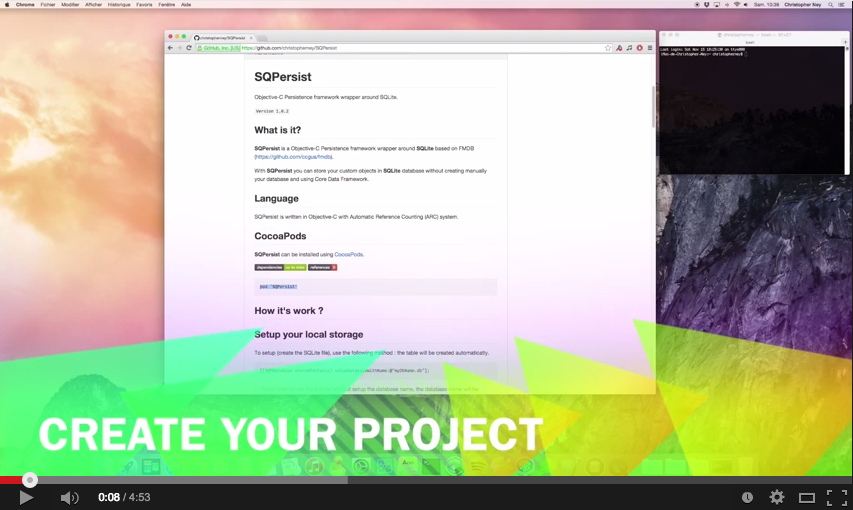Objective-C Persistence framework wrapper around SQLite.
Version 1.0.3
SQPersist is a Objective-C Persistence framework wrapper around SQLite based on FMDB (https://github.com/ccgus/fmdb).
With SQPersist you can store your custom objects in SQLite database without creating manually your database and using Core Data Framework.
SQPersist is written in Objective-C with Automatic Reference Counting (ARC) system.
SQPersist can be installed using CocoaPods.
pod 'SQPersist'
To setup (create the SQLite file), use the following method : the table will be created automaticatly.
[[SQPDatabase sharedInstance] setupDatabaseWithName:@"myDbName.db"];
If your start to use the entities without setup the database name, the database name will be SQPersist.db by default.
Simply inherits your object with the class named SQPObject.
The SQPersist will check if the associating table exists into the database during the first initialization of your object. If not, the table will be created automaticatly.
#import <Foundation/Foundation.h>
#import "SQPObject.h"
@interface Car : SQPObject
@property (nonatomic, strong) NSString *name;
@property (nonatomic, strong) NSString *color;
@property (nonatomic) int power;
@end
The resulting table into the SQLite database will be :
+---------------------------------+
|SQPCar |
+----------+------+-------+-------+
| objectID | name | color | power |
+----------+------+-------+-------+
| -------- | ---- | ----- | ----- |
+----------+------+-------+-------+
| -------- | ---- | ----- | ----- |
+----------+------+-------+-------+
The table will be created during the first initialization of your object (if the table not already exists) :
Car *car1 = [Car SQPCreateEntity];
All objects are identified by an unique identifier named objectID. The objectID is a UUID (NSString).
NSLog(@"Object identifier : %@", car1.objectID);
SQPersist is compatible with the following Objective-C types :
- NSString -> become TEXT into SQLite database
- NSNumber -> become REAL into SQLite database
- NSDecimalNumber -> become REAL into SQLite database
- NSDate -> become INTEGER into SQLite database (Timestamp Since 1970)
- NSData -> become BLOB into SQLite database
- UIImage -> become BLOB into SQLite database
- NSURL -> become TEXT into SQLite database
- int -> become INTEGER into SQLite database
- double -> become REAL into SQLite database
- long -> become INTEGER into SQLite database
- long long -> become INTEGER into SQLite database
- short -> become INTEGER into SQLite database
- float -> become REAL into SQLite database
- bool -> become INTEGER into SQLite database
Warning: the BOOL type is analysed like char, please use bool (lower case).
Each property of entities objects are analysed with Objective-C methods : property_getAttributes().
Apple documentation :
If your object contains some properties of SQPObject type, or NSArray of SQPObject. The children objects will be save too, when you call the method SQPSaveEntity of the main object.
To insert a new object into your database, just call the method named SQPSaveEntity :
// Create Table at the first init (if the table not exists) :
User *userCreated = [User SQPCreateEntity];
userCreated.firstName = @"John";
userCreated.lastName = @"McClane";
// INSERT Object :
[userCreated SQPSaveEntity];
To update an existing object into your database, just call the method named SQPSaveEntity or SQPSaveEntityWithCascade: :
// SELECT BY objectID :
User *existingUser = [User SQPFetchOneByID:objectID];
existingUser.amount = 10.50f;
// UPDATE Object :
[existingUser SQPSaveEntity];
// UPDATE Object (with cascade) :
[existingUser SQPSaveEntityWithCascade:YES];
The cascade option update (or insert) all sub-objects (childrens) contains by the main entity object.
To delete an existing object of your database, set the property deleteObject to YES and call the method named SQPSaveEntity. Or diretcly call the method named SQPDeleteEntity or SQPDeleteEntityWithCascade:.
// DELETE Object :
existingUser.deleteObject = YES;
[existingUser SQPSaveEntity]; // Commit the delete command.
// DELETE Object (without cascade option) :
[existingUser SQPDeleteEntity]; // Commit the delete command.
// DELETE Object (with cascade option) :
[existingUser SQPDeleteEntityWithCascade:YES]; // Commit the delete cascade command.
The cascade option delete all sub-objects (childrens) contains by the main entity object.
To select one objet you can use 3 methods SQPFetchOneByID or SQPFetchOneWhere: or SQPFetchOneByAttribut:withValue:.
// SELECT BY objectID :
User *userSelected = [User SQPFetchOneByID:userCreated.objectID];
// SELECT by condition :
User *userSelected = [User SQPFetchOneWhere:@"lastName = 'McClane'"];
// SELECT by attribute with value :
User *userSelected = [User SQPFetchOneByAttribut:@"lastName" withValue:@"McClane"];
Tips : with SQPFetchOne you can get one object without know the objectID. For example for singleton object :
// SELECT a single row :
AppParameters *params = [AppParameters SQPFetchOne];
To select a collection of objets you can use 4 methods SQPFetchAll, SQPFetchAllWhere:, SQPFetchAllWhere:orderBy: and SQPFetchAllWhere:orderBy:pageIndex:itemsPerPage: :
// SELECT ALL 'Cars' :
NSMutableArray *allCars = [Car SQPFetchAll];
// SELECT ALL 'Ferrari cars' :
NSMutableArray *ferrariCars = [Car SQPFetchAllWhere:@"name = 'Ferrari'"];
// SELECT ALL 'Ferrari cars' ordering by 'power' :
NSMutableArray *ferrariCars = [Car SQPFetchAllWhere:@"name = 'Ferrari' orderBy:@"power DESC"];
// SELECT ALL 'Ferrari cars' ordering by 'power' (first page - with 20 items per page) :
NSMutableArray *ferrariCars = [Car SQPFetchAllWhere:@"name = 'Ferrari' orderBy:@"power DESC" pageIndex:0 itemsPerPage:20];
To count the number of entities you can use 2 methods SQPCountAll or SQPCountAllWhere:.
NSLog(@"Total cars : %lld", [Car SQPCountAll]);
NSLog(@"Total cars 'Ferrari' : %lld", [Car SQPCountAllWhere:@"name = 'Ferrari'"]);
To remove every entities (truncate), use the method SQPTruncateAll.
[Car SQPTruncateAll];
Manage your transactions with 3 methods : beginTransaction, commitTransaction or rollbackTransaction.
[[SQPDatabase sharedInstance] beginTransaction];
// Your objects manipulation...
if (result == YES) {
[[SQPDatabase sharedInstance] commitTransaction];
} else {
[[SQPDatabase sharedInstance] rollbackTransaction];
}
You can remove the database with the method removeDatabase :
// REMOVE Local Database :
[[SQPDatabase sharedInstance] removeDatabase];
Test if database file exists on local :
if ([[SQPDatabase sharedInstance] databaseExists]) {
// SQLite Db file exists.
}
Add new property into an existing table (use just for update your model - generate many SQL request) :
[SQPDatabase sharedInstance].addMissingColumns == YES;
To simply manipulate entity object with JSON requests and responses, all entities have two methods : toDictionary and populateWithDictionary:.
NSDictionary *response = [JSONDictionary objectForKey:@"items"];
Flickr *flickrItem = [Flickr SQPCreateEntity];
[flickrItem populateWithDictionary:response];
User *userCreated = [User SQPCreateEntity];
NSMutableDictionary *requestJson = [userCreated toDictionary];
When you change the structure of your object :
- Clean your Xcode project before rebuild the solution.
- Remove the older database with the method removeDatabase (before changes).
MIT
Free Library
